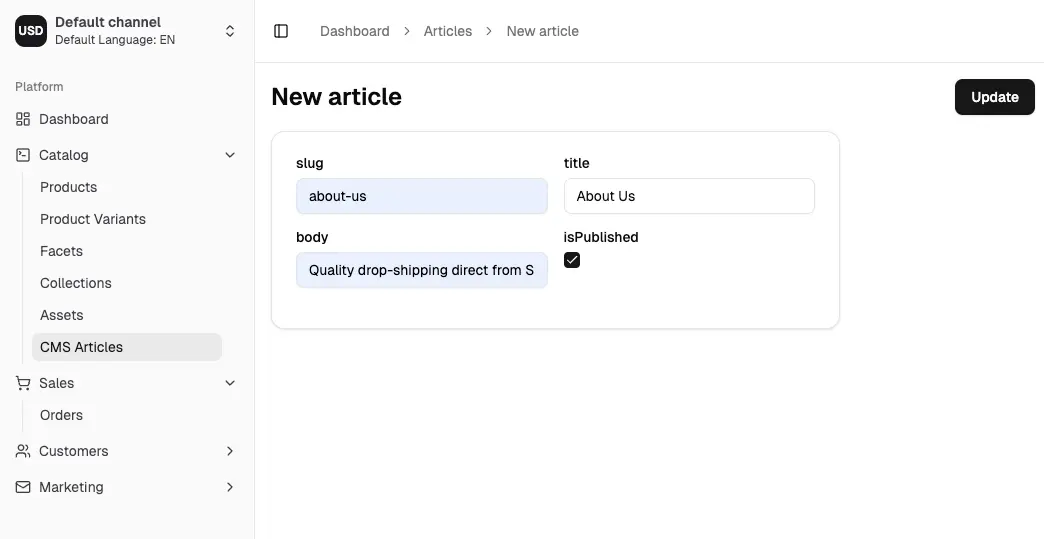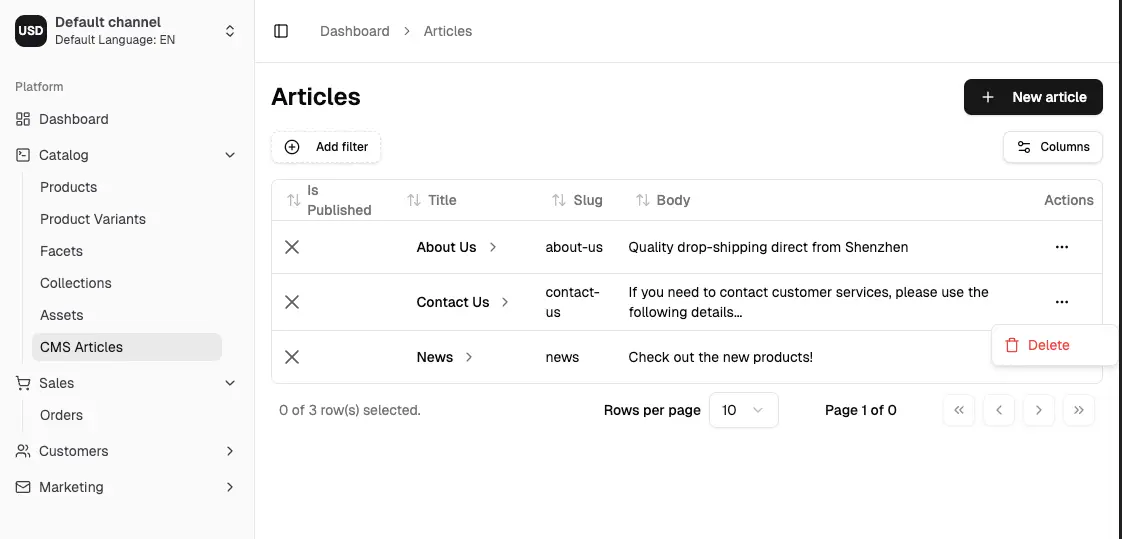Tutorial: Building a CMS Plugin
Follow this guide to see how to extend the dashboard with custom pages, blocks, and components.
We will create a brand new CmsPlugin that implements a simple content management system (CMS) for Vendure in
order to demonstrate how to extend the dashboard.
Creating the plugin
Let's create the plugin:
npx vendure add --plugin cms
Now let's add an entity to the plugin:
npx vendure add --entity Article --selected-plugin CmsPlugin
You now have your CmsPlugin created with a new Article entity. You can find the plugin in the ./src/plugins/cms directory.
Let's edit the entity to add the appropriate fields:
import { DeepPartial, HasCustomFields, VendureEntity } from '@vendure/core';
import { Column, Entity } from 'typeorm';
export class ArticleCustomFields {}
@Entity()
export class Article extends VendureEntity implements HasCustomFields {
constructor(input?: DeepPartial<Article>) {
super(input);
}
@Column()
slug: string;
@Column()
title: string;
@Column('text')
body: string;
@Column()
isPublished: boolean;
@Column(type => ArticleCustomFields)
customFields: ArticleCustomFields;
}
Now let's create a new ArticleService to handle the business logic of our new entity:
npx vendure add --service ArticleService --selected-plugin CmsPlugin --selected-entity Article
The service will be created in the ./src/plugins/cms/services directory.
Finally, we'll extend the GraphQL API to expose those CRUD operations:
npx vendure add --api-extension CmsPlugin --selected-service ArticleService --query-name ArticleQuery
Now the api extensions and resolver has been created in the ./src/plugins/cms/api-extensions directory.
The last step is to create a migration for our newly-created entity:
npx vendure migrate --generate article
Setting up Dashboard extensions
Dashboard extensions are declared directly on the plugin metadata. Unlike the old AdminUiPlugin, you do not need to separately declare ui extensions anywhere except on the plugin itself.
@VendurePlugin({
// ...
entities: [Article],
adminApiExtensions: {
schema: adminApiExtensions,
resolvers: [ArticleAdminResolver],
},
dashboard: './dashboard/index.tsx',
})
export class CmsPlugin {
// ...
}
Now we'll create the entry point of our dashboard extension:
import { defineDashboardExtension } from '@vendure/dashboard';
export default defineDashboardExtension({
// Let's add a simple test page to check things are working
routes: [
{
component: () => <div>Test Page Works!</div>,
path: '/test',
navMenuItem: {
id: 'test',
title: 'Test Page',
sectionId: 'catalog',
},
},
],
});
Restart the Vite server (q, enter to quit if still running), and then you should be able to see your new test page!
Creating a list page
Now that the test page is working, let's create a list page for our Article entity.
First we'll create a new article-list.tsx file in the ./src/plugins/cms/dashboard directory:
import {
Button,
DashboardRouteDefinition,
ListPage,
PageActionBarRight,
DetailPageButton,
} from '@vendure/dashboard';
import { Link } from '@tanstack/react-router';
import { PlusIcon } from 'lucide-react';
// This function is generated for you by the `vendureDashboardPlugin` in your Vite config.
// It uses gql-tada to generate TypeScript types which give you type safety as you write
// your queries and mutations.
import { graphql } from '@/gql';
// The fields you select here will be automatically used to generate the appropriate columns in the
// data table below.
const getArticleList = graphql(`
query GetArticles($options: ArticleListOptions) {
articles(options: $options) {
items {
id
createdAt
updatedAt
isPublished
title
slug
body
customFields
}
}
}
`);
const deleteArticleDocument = graphql(`
mutation DeleteArticle($id: ID!) {
deleteArticle(id: $id) {
result
}
}
`);
export const articleList: DashboardRouteDefinition = {
navMenuItem: {
sectionId: 'catalog',
id: 'articles',
url: '/articles',
title: 'CMS Articles',
},
path: '/articles',
loader: () => ({
breadcrumb: 'Articles',
}),
component: route => (
<ListPage
pageId="article-list"
title="Articles"
listQuery={getArticleList}
deleteMutation={deleteArticleDocument}
route={route}
customizeColumns={{
title: {
cell: ({ row }) => {
const post = row.original;
return <DetailPageButton id={post.id} label={post.title} />;
},
},
}}
>
<PageActionBarRight>
<Button asChild>
<Link to="./new">
<PlusIcon className="mr-2 h-4 w-4" />
New article
</Link>
</Button>
</PageActionBarRight>
</ListPage>
),
};
Let's register this route (and we can also remove the test page) in our index.tsx file:
import { defineDashboardExtension } from '@vendure/dashboard';
import { articleList } from './article-list';
export default defineDashboardExtension({
routes: [
articleList,
],
});
You should now be able to see the list view, which will be empty:

Creating a detail page
Now let's create a detail page so we can start adding articles.
We'll begin with the simplest approach, where the form will be auto-generated for us based on the GraphQL schema using the DetailPage component. This is useful for quickly getting started, but you will probably want to customize the form later on.
Create a new file called article-detail.tsx in the ./src/plugins/cms/dashboard directory:
import { DashboardRouteDefinition, DetailPage, detailPageRouteLoader } from '@vendure/dashboard';
import { graphql } from '@/gql';
const articleDetailDocument = graphql(`
query GetArticleDetail($id: ID!) {
article(id: $id) {
id
createdAt
updatedAt
isPublished
title
slug
body
customFields
}
}
`);
const createArticleDocument = graphql(`
mutation CreateArticle($input: CreateArticleInput!) {
createArticle(input: $input) {
id
}
}
`);
const updateArticleDocument = graphql(`
mutation UpdateArticle($input: UpdateArticleInput!) {
updateArticle(input: $input) {
id
}
}
`);
export const articleDetail: DashboardRouteDefinition = {
path: '/articles/$id',
loader: detailPageRouteLoader({
queryDocument: articleDetailDocument,
breadcrumb: (isNew, entity) => [
{ path: '/articles', label: 'Articles' },
isNew ? 'New article' : entity?.title,
],
}),
component: route => {
return (
<DetailPage
pageId="article-detail"
queryDocument={articleDetailDocument}
createDocument={createArticleDocument}
updateDocument={updateArticleDocument}
route={route}
title={article => article?.title ?? 'New article'}
setValuesForUpdate={article => {
return {
id: article?.id ?? '',
isPublished: article?.isPublished ?? false,
title: article?.title ?? '',
slug: article?.slug ?? '',
body: article?.body ?? '',
};
}}
/>
);
},
};
Now we can register this route in our index.tsx file:
import { defineDashboardExtension } from '@vendure/dashboard';
import { articleList } from './article-list';
import { articleDetail } from './article-detail';
export default defineDashboardExtension({
routes: [
articleList,
articleDetail,
],
});
You should now be able to click on the "New article" button in the list view, and see the detail page:

Congratulations! You can now add, edit and delete articles in the dashboard.

Customizing the detail page
The auto-generated DetailPage is a great way to get started and quickly be able to interact with your entities. But let's now see how we can fully customize the layout and form fields.
import {
DashboardRouteDefinition,
detailPageRouteLoader,
useDetailPage,
Page,
PageTitle,
PageActionBar,
PageActionBarRight,
PermissionGuard,
Button,
PageLayout,
PageBlock,
FormFieldWrapper,
DetailFormGrid,
Switch,
Input,
RichTextInput,
CustomFieldsPageBlock,
} from '@vendure/dashboard';
import { AnyRoute, useNavigate } from '@tanstack/react-router';
import { toast } from 'sonner';
import { graphql } from '@/gql';
const articleDetailDocument = graphql(`
query GetArticleDetail($id: ID!) {
article(id: $id) {
id
createdAt
updatedAt
isPublished
title
slug
body
customFields
}
}
`);
const createArticleDocument = graphql(`
mutation CreateArticle($input: CreateArticleInput!) {
createArticle(input: $input) {
id
}
}
`);
const updateArticleDocument = graphql(`
mutation UpdateArticle($input: UpdateArticleInput!) {
updateArticle(input: $input) {
id
}
}
`);
export const articleDetail: DashboardRouteDefinition = {
path: '/articles/$id',
loader: detailPageRouteLoader({
queryDocument: articleDetailDocument,
breadcrumb: (isNew, entity) => [
{ path: '/articles', label: 'Articles' },
isNew ? 'New article' : entity?.title,
],
}),
component: route => {
return <ArticleDetailPage route={route} />;
},
};
function ArticleDetailPage({ route }: { route: AnyRoute }) {
const params = route.useParams();
const navigate = useNavigate();
const creatingNewEntity = params.id === 'new';
const { form, submitHandler, entity, isPending, resetForm } = useDetailPage({
queryDocument: articleDetailDocument,
createDocument: createArticleDocument,
updateDocument: updateArticleDocument,
setValuesForUpdate: article => {
return {
id: article?.id ?? '',
isPublished: article?.isPublished ?? false,
title: article?.title ?? '',
slug: article?.slug ?? '',
body: article?.body ?? '',
};
},
params: { id: params.id },
onSuccess: async data => {
toast('Successfully updated article');
resetForm();
if (creatingNewEntity) {
await navigate({ to: `../$id`, params: { id: data.id } });
}
},
onError: err => {
toast('Failed to update article', {
description: err instanceof Error ? err.message : 'Unknown error',
});
},
});
return (
<Page pageId="article-detail" form={form} submitHandler={submitHandler}>
<PageTitle>{creatingNewEntity ? 'New article' : (entity?.title ?? '')}</PageTitle>
<PageActionBar>
<PageActionBarRight>
<PermissionGuard requires={['UpdateProduct', 'UpdateCatalog']}>
<Button
type="submit"
disabled={!form.formState.isDirty || !form.formState.isValid || isPending}
>
Update
</Button>
</PermissionGuard>
</PageActionBarRight>
</PageActionBar>
<PageLayout>
<PageBlock column="side" blockId="publish-status">
<FormFieldWrapper
control={form.control}
name="isPublished"
label="Is Published"
render={({ field }) => (
<Switch checked={field.value} onCheckedChange={field.onChange} />
)}
/>
</PageBlock>
<PageBlock column="main" blockId="main-form">
<DetailFormGrid>
<FormFieldWrapper
control={form.control}
name="title"
label="Title"
render={({ field }) => <Input {...field} />}
/>
<FormFieldWrapper
control={form.control}
name="slug"
label="Slug"
render={({ field }) => <Input {...field} />}
/>
</DetailFormGrid>
<FormFieldWrapper
control={form.control}
name="body"
label="Content"
render={({ field }) => (
<RichTextInput value={field.value ?? ''} onChange={field.onChange} />
)}
/>
</PageBlock>
<CustomFieldsPageBlock column="main" entityType="Article" control={form.control} />
</PageLayout>
</Page>
);
}
In the above example, we have:
- Used the Page, PageTitle, PageActionBar and PageLayout components to create a layout for our page.
- Used PageBlock components to structure the page into blocks.
- Used custom form components (such as the
RichTextInput) to better represent the data.
API Reference
A partial API reference of the new Dashboard API can be found here: